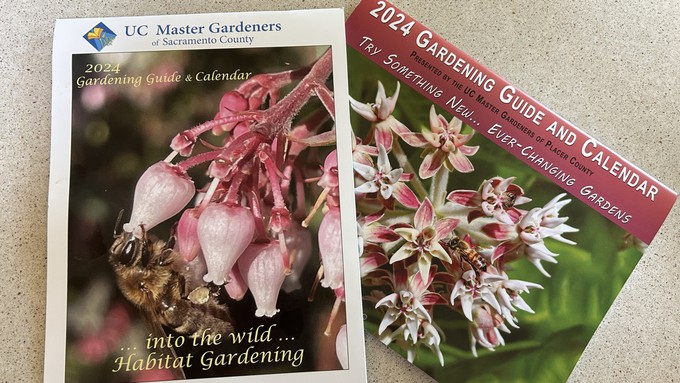
Sacramento, Placer master gardeners stuff these guides with useful information

Great minds think alike! The two gardening guides both have 2024 covers with bees and native flowering plants. But the content is different -- and tailored for each growing area. Kathy Morrison
We have just one month until the 2024 gardening season begins. And there's even less time to shop for holiday gifts for gardener friends and relatives.
Here's my best suggestion to cover both situations: Get yourself -- and those gardening gift recipients -- a 2024 Gardening Guide and Calendar. Both the Sacramento and Placer counties' master gardener groups produce stunning and incredibly useful versions, tailored to the gardens in our region. (Full disclosure: I'm one of the contributing writers to the Sacramento version.)
The price is right, just $12 each including sales tax, and available online or at area nurseries/retail outlets. Sacramento's can be ordered here; the retail sellers are listed on the same page. Placer's order page is here, which also includes a link to the retailers carrying it in Placer, Nevada and El Dorado counties.
Prices for calendars purchased at retailers may be slightly higher; online orders include postage costs.
Both gardening guides are fundraisers to support these busy master gardener programs, which rely tremendously on volunteers and donations.
If you want to order online, I would hurry and do it before Dec. 8. I've heard though the grapevine that UC Agriculture and Natural Resources -- the UC Cooperative Extension's umbrella department -- will be moving its servers to a new data center Dec. 8-10, so the websites will be down for that period.
So what's in these calendars? The Sacramento guide for 2024 focuses on "Habitat Gardening, " with calendar pages devoted to plants that benefit wildlife. January, for example, focuses on native oaks, a "keystone species" for California birds, butterflies and other insects. Behind the calendar pages is essentially a mini course on habitat gardening, discussing plant families, beneficials, local habitats to visit and bird-friendly practices. The Sacramento month-by-month planting chart is a standard part of the annual guide.
The Placer master gardeners in their Valley- and foothills-tailored guide suggest "Try Something New." February's article, for example, looks at "Redefining Your Garden," perfect for the time of year when planning rather than planting is a gardener's primary activity. April's page discusses "Succulents in Small Spaces," certainly a great topic for folks with limited growing space.
Both guides are like having a master gardener in your back pocket, plus an at-your-fingertips place to record weather notes, monthly reminders and quarterly garden duties. (Sprayed your peach trees yet?) I really couldn't garden without mine!
Comments
0 comments have been posted.Sacramento Digs Gardening to your inbox.
Sites We Like
Garden Checklist for week of July 21
Your garden needs you!
* Keep your vegetable garden watered, mulched and weeded. Water before 8 a.m. to reduce the chance of fungal infection and to conserve moisture.
* Feed vegetable plants bone meal, rock phosphate or other fertilizers high in phosphate to stimulate more blooms and fruiting. (But wait until daily high temperatures drop out of the 100s.)
* Don’t let tomatoes wilt or dry out completely. Give tomatoes a deep watering two to three times a week.
* Harvest vegetables promptly to encourage plants to produce more. Squash especially tends to grow rapidly in hot weather. Keep an eye on zucchini.
* Pinch back chrysanthemums for bushy plants and more flowers in September.
* Remove spent flowers from roses, daylilies and other bloomers as they finish flowering.
* Pinch off blooms from basil so the plant will grow more leaves.
* Cut back lavender after flowering to promote a second bloom.
* It's not too late to add a splash of color. Plant petunias, snapdragons, zinnias and marigolds.
* From seed, plant corn, pumpkins, radishes, winter squash and sunflowers.